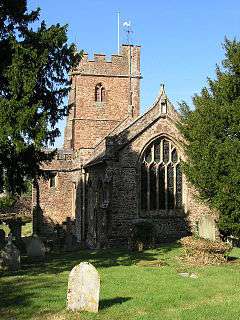Church of St George, Bicknoller
| Church of St George | |
|---|---|
 | |
 Location within Somerset | |
| General information | |
| Town or city | Bicknoller |
| Country | England |
| Coordinates | 51°08′50″N 3°16′22″W / 51.1471°N 3.2727°W |
| Completed | 12th century |
The Church of St George in Bicknoller, Somerset, England dates from the 12th century and has been designated as a Grade I listed building.[1]
The church is dominated by a 1000-year-old elm tree in its grounds.[2]
The church, which is decorated with a collection of carved angels and nightmarish animal heads, was largely rebuilt in the 15th and 16th centuries.[3]
The interior includes a 12th-century pillar piscina.[4] There is a memorial to William Temple, Archbishop of Canterbury, who spent his holidays in the village from 1933 to 1944.[5]
The organ dates from 1922 and has a carved oak case. It was built by the Positive Organ Company.[6] The bells in the tower include one which was previously at St Saviour's in Larkhall, Bath.[7] In 2012 plans were underway to install and sixth bell.[8]
The parish is part of the Quantock Towers benefice within the Taunton archdeaconry.[9]
See also
| Wikimedia Commons has media related to St George's Church, Bicknoller. |
References
- ↑ "Church of St George". Images of England. Retrieved 2006-08-18.
- ↑ "Bicknoller". Quantock Online. Retrieved 20 October 2012.
- ↑ "Bicknoller St. George". Dawson Heritage. Retrieved 20 October 2012.
- ↑ R.W. Dunning (editor), A.P. Baggs, R.J.E. Bush, M.C. Siraut (1985). "Parishes: Bicknoller". A History of the County of Somerset: Volume 5. Institute of Historical Research. Retrieved 20 October 2012.
- ↑ Waite, Vincent (1964). Portrait of the Quantocks. London: Robert Hale. ISBN 0-7091-1158-4.
- ↑ "Positive Organ Company". John Speller. Retrieved 20 October 2012.
- ↑ "St George, Bicknoller, Somerset". Keltek Trust. Retrieved 20 October 2012.
- ↑ "Village rings out bell appeal". West Somerset Free Press. Retrieved 20 October 2012.
- ↑ "St George, Bicknoller". Church of England. Retrieved 20 October 2012.